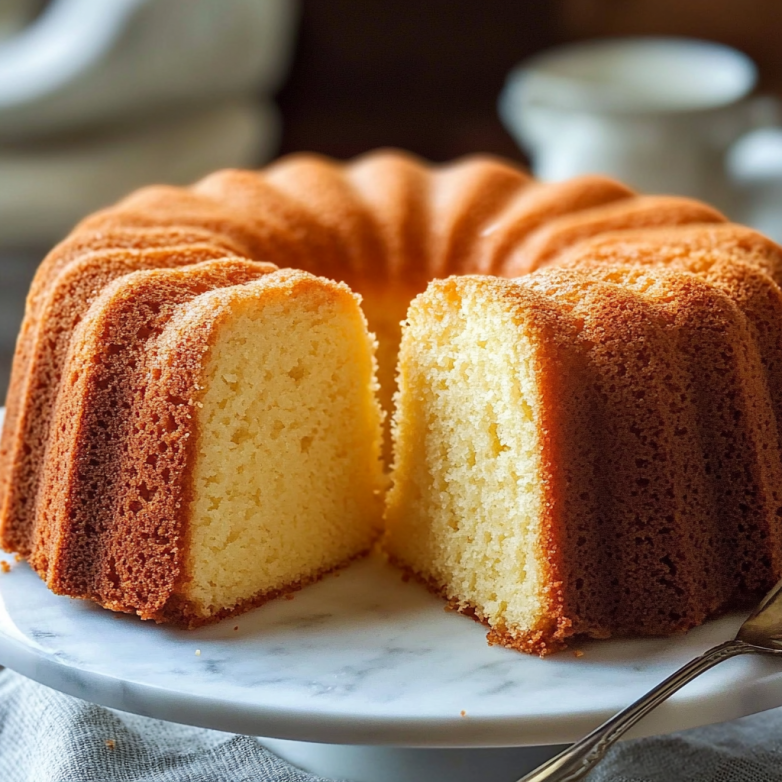A Rich, Buttery Classic That Melts in Your Mouth
Ready to master a timeless dessert that never goes out of style? This rich and velvety pound cake delivers buttery goodness and a soft, tender crumb that’s perfect for every occasion—from casual brunches to elegant dinner parties. Follow along for a foolproof recipe and tips that ensure success every time.
Introduction
When it comes to classic baked goods, few desserts can compete with the pure, unadulterated joy of a perfectly baked pound cake. With its golden crust, moist crumb, and rich buttery flavor, pound cake is a nostalgic treat that has graced Southern tables for generations.
This particular version of pound cake is often called “the best ever” for a reason. It uses just a handful of pantry staples and relies on precise technique and the magic of real butter to create a moist, dense, yet soft and deliciously flavorful cake. Whether you serve it plain, topped with fruit, or drizzled with glaze, this cake is guaranteed to steal the spotlight.
In this guide, we’ll walk you through everything you need—from tools and tips to FAQs and storage solutions—so you can bake the best pound cake ever with confidence and pride.
Tools Needed, Servings, and Baking Time
Tools You’ll Need:
- Stand mixer or hand mixer
- Mixing bowls
- Measuring cups and spoons
- Rubber spatula
- Whisk
- 10-inch tube pan or bundt pan
- Oven
- Cooling rack
Servings:
- Serves 12–16 slices
Time Required:
- Prep Time: 20 minutes
- Bake Time: 1 hour 15 minutes to 1 hour 30 minutes
- Cooling Time: 1 hour
- Total Time: About 2 hours 30 minutes
Ingredients
To make the best pound cake ever, you’ll need the following simple ingredients:
- 2 ½ cups all-purpose flour
- ½ teaspoon baking powder
- ½ teaspoon salt
- 1 ½ cups (3 sticks) unsalted butter, softened to room temperature
- 3 cups granulated sugar
- 6 large eggs, at room temperature
- 1 teaspoon vanilla extract
Step-by-Step Instructions
Step 1: Preheat and Prepare
Start by preheating your oven to 325°F (163°C). Grease and lightly flour a 10-inch tube or bundt pan to ensure the cake releases cleanly after baking. You can also use baking spray with flour included for ease.
Step 2: Mix the Dry Ingredients
In a medium mixing bowl, whisk together the all-purpose flour, baking powder, and salt. This step ensures your leavening agent is evenly distributed and will help the cake rise beautifully.
Set this dry mixture aside while you cream the butter and sugar.
Step 3: Cream the Butter and Sugar
In a large mixing bowl (or the bowl of a stand mixer), beat the softened butter on medium speed until smooth and creamy—about 1 minute.
Gradually add the granulated sugar while continuing to beat. This step is crucial: cream the butter and sugar together for at least 5 minutes, until the mixture is pale, light, and fluffy. This process adds air to the batter and helps create the perfect texture.
Step 4: Add the Eggs One at a Time
Reduce the mixer speed to low. Add the eggs, one at a time, making sure each egg is fully incorporated before adding the next. Scrape down the sides of the bowl occasionally to ensure an even mix.
This slow addition ensures the mixture remains stable and emulsified, which prevents curdling and ensures a smooth batter.
Step 5: Add Vanilla Extract
Mix in the vanilla extract, blending until evenly distributed throughout the batter. Vanilla enhances the overall flavor and balances the richness of the butter and eggs.
Step 6: Combine Dry Ingredients
Gradually add the dry flour mixture to the wet batter in three additions, mixing just until combined after each. Avoid overmixing, which can lead to a dense or tough cake.
Use a rubber spatula to give the batter one final gentle mix, scraping the bottom and sides to ensure everything is fully blended.
Step 7: Bake the Cake
Pour the batter evenly into your prepared bundt or tube pan, smoothing the top with a spatula. Tap the pan gently on the counter to release any air bubbles.
Bake for 1 hour 15 minutes to 1 hour 30 minutes, or until a toothpick inserted in the center comes out clean or with just a few moist crumbs.
Avoid opening the oven door during the first 60 minutes of baking to ensure even rising and prevent collapse.
Step 8: Cool and Serve
Remove the cake from the oven and place it on a wire rack to cool in the pan for 15–20 minutes. Then, carefully invert it onto the rack to cool completely before slicing.
Letting the cake cool thoroughly enhances its flavor and ensures it holds its shape when cut.
Tips for Pound Cake Success
- Use Room Temperature Ingredients: Butter, eggs, and even the vanilla should be at room temperature for best incorporation. This promotes even mixing and the ideal batter consistency.
- Cream Thoroughly: Don’t rush the creaming step. It’s critical for incorporating air into the batter and achieving a light, tender texture.
- Don’t Overmix After Adding Flour: Once the flour goes in, mix only until the ingredients are combined. Overmixing activates gluten and leads to a tough cake.
- Check for Doneness: Oven times vary. Start checking at the 1 hour 15 minute mark. A clean toothpick means the cake is ready.
- Cool Before Cutting: Pound cake needs time to set. Cooling completely before slicing keeps it moist and firm.
Serving and Storage Tips
Serving Suggestions:
- Serve plain or dusted with powdered sugar
- Add a drizzle of lemon glaze or chocolate ganache
- Pair with fresh berries and whipped cream
- Toast slices and serve with butter for breakfast
Storage:
- Room Temperature: Store in an airtight container for up to 4 days.
- Refrigerator: Wrap tightly and refrigerate for up to 1 week. Bring to room temperature before serving.
- Freezer: Wrap slices or the entire cake tightly in plastic wrap and foil. Freeze for up to 3 months. Thaw overnight in the refrigerator before serving.
Frequently Asked Questions
1. Can I use salted butter instead of unsalted?
Yes, but reduce the added salt in the recipe to ¼ teaspoon to avoid an overly salty taste.
2. Why did my pound cake turn out dry?
This can happen if the cake was overbaked or too much flour was added. Always spoon and level flour into the measuring cup and check your oven with an oven thermometer for accuracy.
3. Can I add other flavors to the batter?
Absolutely! Lemon zest, almond extract, or even rum can enhance the flavor. Just be careful not to overwhelm the base flavor with too much extract.
4. What’s the difference between a bundt pan and tube pan?
A bundt pan has decorative designs, while a tube pan is usually plain with straight sides. Both work, but greasing well is key for easy release.
5. Can I make this pound cake in loaf pans?
Yes, this recipe makes two standard 9×5-inch loaves. Adjust the baking time to 60–70 minutes and check with a toothpick for doneness.
Conclusion
There’s something undeniably special about a well-made pound cake. With its rich, buttery flavor and moist, tender crumb, it’s a dessert that brings joy with every slice. Whether you’re baking it for a holiday celebration, a family dinner, or just because you love good cake, this recipe is the one to turn to.
By using high-quality ingredients, following the mixing steps carefully, and baking with attention, you can create a pound cake that earns compliments every time. Best of all, it’s incredibly versatile—serve it plain, dress it up, or freeze some for later.
So what are you waiting for? Gather your ingredients, preheat your oven, and experience the joy of baking the best pound cake ever. You won’t regret it—and neither will anyone lucky enough to get a slice.

